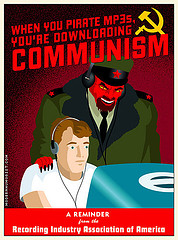 The good people at the Open Rights Group forwarded me an email they received from a Doctor Who fan that goes by the screen name Mazzmatazz, who has allowed me to tell his/her story. But beware, this is a scary tale of copyright abuse that will have you hiding behind the sofa, or perhaps it will send you into a Whogasm.
The good people at the Open Rights Group forwarded me an email they received from a Doctor Who fan that goes by the screen name Mazzmatazz, who has allowed me to tell his/her story. But beware, this is a scary tale of copyright abuse that will have you hiding behind the sofa, or perhaps it will send you into a Whogasm.
Doctor Who series Four started a few weeks ago with the episode "Partners in Crime". The episode featured a new creature generated from human fat called, what else, the Adipose (pictured below). While I did not particularly like the episode, I reckon that the Adipose made a good showing, and will probably become a memorable Doctor Who creature (much better surely than the lovable yet ludicrous Abzorbaloff). The Adipose however, seem to me to be the Doctor Who equivalent of Ewoks - small and cute creatures which serve little purpose to the plot, and whose value seems to be mainly as merchandising fodder (I notice that others agree).
Enter Mazzmatazz. Mazz has a website featuring photography and knitting. In a display of amazing knitting talent (and dare I say, too much time on their hands), Mazz has been making knitting designs of Doctor Who characters; see for example, the excellent Ood. Under normal circumstances, a fan who makes knitting designs of loved TV characters should not be the concern of copyright owners. However, these are not normal circumstances. The new Doctor Who series is merchandising gold, so much so that the BBC has been climbing up the world merchandise chart. This may confuse people in and outside of the UK. The BBC is not a commercial enterprise, is it? We in the UK have to pay licensing fees (costing a whooping £139.50 GBP per year) to support public broadcasting, so why are the BBC relying so much on their merchandising?
 This is a good time to get acquainted with how the BBC works. While the BBC in the UK is free of advertising and supported partially by the licensing fee, expensive quality programs such as Doctor Who and Torchwood require investment that goes above and beyond guaranteed funding through licence fees alone. The BBC therefore has an international commercial body called BBC Worldwide, which sells its valuable intellectual property to the world entertainment market. The wide success of titles such as Planet Earth and Doctor Who have pushed BBC Worldwide's sales to more than £800 million GBP, and merchandising is a key part of that strategy.
This is a good time to get acquainted with how the BBC works. While the BBC in the UK is free of advertising and supported partially by the licensing fee, expensive quality programs such as Doctor Who and Torchwood require investment that goes above and beyond guaranteed funding through licence fees alone. The BBC therefore has an international commercial body called BBC Worldwide, which sells its valuable intellectual property to the world entertainment market. The wide success of titles such as Planet Earth and Doctor Who have pushed BBC Worldwide's sales to more than £800 million GBP, and merchandising is a key part of that strategy.
Where does our friend Mazz fit in this picture of corporate success? Well, it seems that the Adipose knitting designs have hit a greed nerve somewhere at the Beeb. While I have a copy of the entire communication between Mazz and the BBC, I will reproduce it partially because the emails come with a confidentiality disclaimer (although I must point out that I believe, as others do, that those email disclaimers are not even worth the bits they are written on). The cease-and-desist letter reads:
"We note that you are supplying DR WHO items, and using trade marks and copyright owned by BBC. You have not been given permission to use the DR WHO brand and we ask that you remove from your site any designs connected with DR WHO. Please reply acknowledging receipt of this email, and confirm that you will remove the DR WHO items as requested."
Interesting choice of words to say the least. Further communication continues to stress the point that Mazz's designs constitute unlicensed merchandise, and that BBC Worldwide has every right to stop others from distributing their property. However, Mazz is not selling merchandise, he/she is providing a knitting design to tell others how to make their own versions of the Adipose. While commercial exploitation has no bearing on whether there is copyright infringement, I think that it should be a huge consideration for BBC Worldwide when deciding to prosecute a fan who clearly loves the show.
What about the legal argument? Does the BBC have a case? On the face of it, the BBC would be correct in their assessment that Mazz is infringing their copyright. TV characters are protected by copyright, and all sorts of fan art would be found to be infringing. However, there is a
growing body of literature on the subject of the uneasy interaction between fandom and copyright, as many authors turn a blind eye to non-commercial use of their characters online. Of course, when the work becomes commercial,
they will take action.
However, Mazz's case is more complicated, as
copyright is less clear about transformative art. Nobody would claim that Andy Warhol does not have copyright over his iconic Marilyn portrait, or his Campbell's Soup montages, even if they use other's IP. Similarly, there have been various cases where the mere transformation for artistic purposes from one medium to another was deemed to have enough originality to warrant its own copyright protection (see for example
Alfred Bell v Catalda). However, copy too much and you might be found to be infringing, the prime example is
Roger v Koons, pictured above. While U.S. cases seem to be moving against transformative copyright, the same cannot be said for case law here in the UK.

My first reaction when I read about Mazz's knitting case was that this was straightforward infringement, but something kept nagging me. I asked our resident copyright expert
Charlotte Waelde, and she remembered some case law which blurs the picture even more. In King Features Syndicate v Kleeman [1941] AC 417, the defendant was accused of having copied cartoon strips depicting "Popeye the Sailor" and placing them in brooches and other media. Although the defendants lost, the issue of the independent design was explored. The Lords found that the figures could constitute designs as protected in the then Copyright Designs and Patents Act 1907. Another relevant case is Anacon v Environmental Research Technology [1994] FSR 659. This case has nothing to do with art, but with circuit design. In this case the defendants made a list of the components in a circuit and their interaction with one another, and then made a circuit on its own that looked completely different to the original. The defendants claimed that the their design was artistic, and therefore different. However, Jacob J found that the actual list was a literary work, and therefore it was subject to copyright protection as such. This is relevant to Mazz's design, as it proves that a knitting design is subject to its own protection, and that it may be dissimilar to the actual artistic depiction of the character. This issue was also explored in
Sandman v Panasonic, where Pumfrey J astutely described the dichotomy between design and the item resulting from it to that of musical notation and the resulting tune. Each has its own type of protection.
In other words, I strongly believe that BBC Worldwide's claims are over-reaching. While there could be infringement, I submit the hypothesis that Mazz has done enough transformation to the Adipose character to claim copyright over their design.
The cease-and-desist letter also makes a claim on trade marks. I know next to nothing about this subject, but I would be extremely surprised if BBC Worldwide had managed to register the "Adipose" mark. I did a quick search in the
UK-IPO Trade Mark database and I could not find it registered.
Concluding, the BBC may not have a straightforward case if they decide to sue, and they could very well lose. I also believe that they are misplacing their energies pursuing a fan who has done nothing more than to display their love to the show by making a highly original design. While commercial use is not relevant to the infringement case, it should be noted that Mazz was not selling the design, and had actually licensed it under a Creative Commons licence.
So, will the real Adipose please stand up?
Update: I have been dusting off my copyright textbooks looking for more cases relevant to this issue. The important question to me is whether a design arising from a character is an infringement. I have not found anything specifically, but generally copyright protects an original work in most changes of form (say, if a 3D sculpture is made of a 2D image). However, instructions to make things, such as knitting patterns and recipes, are protected only as literary or artistic works, therefore, the item produced from such instructions is not infringing the original design (see Bridgid Folley v Elliot [1982] RPC 433). I have not found a single case however that answers the question of whether there is infringement if the form of the protected character is changed into instructions. Anyone out in the blogosphere know of such a case? Again, Sandman v Panasonic is the closest analogy that I could find, but it is not an exact match.
 (via ORG-discuss list) Pirates, pirates, pirates. it's all there is in the news lately. Pirates in Somalia, pirates in Sweden, pirates online, pirates in culture. We have pirates jumping out of our breakfast cereals it seems. Last week saw the pinnacle of hyperbolic coverage of piracy of the Internet sort when the Pirate Bay operators were sentenced to a year in jail. We were promised by talking heads on TV that the ruling would be the beginning of the end of internet piracy, and that a new and happy future where everyone respects copyright law is finally within reach.
(via ORG-discuss list) Pirates, pirates, pirates. it's all there is in the news lately. Pirates in Somalia, pirates in Sweden, pirates online, pirates in culture. We have pirates jumping out of our breakfast cereals it seems. Last week saw the pinnacle of hyperbolic coverage of piracy of the Internet sort when the Pirate Bay operators were sentenced to a year in jail. We were promised by talking heads on TV that the ruling would be the beginning of the end of internet piracy, and that a new and happy future where everyone respects copyright law is finally within reach.
 del.icio.us
del.icio.us
















